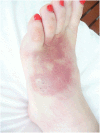Death adder envenoming causes neurotoxicity not reversed by antivenom--Australian Snakebite Project (ASP-16)
- PMID: 23029595
- PMCID: PMC3459885
- DOI: 10.1371/journal.pntd.0001841
Death adder envenoming causes neurotoxicity not reversed by antivenom--Australian Snakebite Project (ASP-16)
Abstract
Background: Death adders (Acanthophis spp) are found in Australia, Papua New Guinea and parts of eastern Indonesia. This study aimed to investigate the clinical syndrome of death adder envenoming and response to antivenom treatment.
Methodology/principal findings: Definite death adder bites were recruited from the Australian Snakebite Project (ASP) as defined by expert identification or detection of death adder venom in blood. Clinical effects and laboratory results were collected prospectively, including the time course of neurotoxicity and response to treatment. Enzyme immunoassay was used to measure venom concentrations. Twenty nine patients had definite death adder bites; median age 45 yr (5-74 yr); 25 were male. Envenoming occurred in 14 patients. Two further patients had allergic reactions without envenoming, both snake handlers with previous death adder bites. Of 14 envenomed patients, 12 developed neurotoxicity characterised by ptosis (12), diplopia (9), bulbar weakness (7), intercostal muscle weakness (2) and limb weakness (2). Intubation and mechanical ventilation were required for two patients for 17 and 83 hours. The median time to onset of neurotoxicity was 4 hours (0.5-15.5 hr). One patient bitten by a northern death adder developed myotoxicity and one patient only developed systemic symptoms without neurotoxicity. No patient developed venom induced consumption coagulopathy. Antivenom was administered to 13 patients, all receiving one vial initially. The median time for resolution of neurotoxicity post-antivenom was 21 hours (5-168). The median peak venom concentration in 13 envenomed patients with blood samples was 22 ng/mL (4.4-245 ng/mL). In eight patients where post-antivenom bloods were available, no venom was detected after one vial of antivenom.
Conclusions/significance: Death adder envenoming is characterised by neurotoxicity, which is mild in most cases. One vial of death adder antivenom was sufficient to bind all circulating venom. The persistent neurological effects despite antivenom, suggests that neurotoxicity is not reversed by antivenom.
Conflict of interest statement
The authors have declared that no competing interests exist.
Figures
References
-
- Wuster W, Dumbrell AJ, Hay C, Pook CE, Williams DJ, et al. (2005) Snakes across the Strait: trans-Torresian phylogeographic relationships in three genera of Australasian snakes (Serpentes: Elapidae: Acanthophis, Oxyuranus, and Pseudechis). Mol Phylogenet Evol 34: 1–14. - PubMed
-
- Sutherland SKT, J. (2001) Australian animals toxins: the creatures, their toxins, and care of the poisoned patient. Melbourne: Oxford University Press.
-
- Tyler MI, Retson-Yip KV, Gibson MK, Barnett D, Howe E, et al. (1997) Isolation and amino acid sequence of a new long-chain neurotoxin with two chromatographic isoforms (Aa el and Ae e2) from the venom of the Australian death adder (Acanthophis antarcticus). Toxicon 35: 555–562. - PubMed
-
- Sheumack DD, Howden ME, Spence I (1979) Isolation and partial characterisation of a lethal neurotoxin from the venom of the Australian death adder (Acanthophis antarcticus). Toxicon 17: 609–616. - PubMed
Publication types
MeSH terms
Substances
LinkOut - more resources
Full Text Sources
Medical
Miscellaneous



